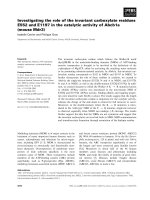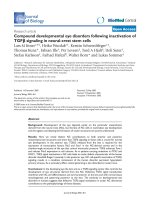ROLE OF THE ERP29 IN MIGRATION, APOPTOSIS AND PROLIFERATION IN BONE MARROW STEM CELLS
Bạn đang xem bản rút gọn của tài liệu. Xem và tải ngay bản đầy đủ của tài liệu tại đây (2.38 MB, 96 trang )
THE ROLE OF ERp29 IN MIGRATION, APOPTOSIS AND
PROLIFERATION IN BONE MARROW STEM CELLS
WANG YU
(M. Md., Wuhan University)
A THESIS SUBMITTED
FOR THE DEGREE OF MASTER OF SCIENCE
DEPARTMENT OF ANATOMY
YONG LOO LIN SCHOOL OF MEDICINE
NATIONAL UNIVERSITY OF SINGAPORE
2012
Declaration
I hereby declare that this thesis is my original work and it has been written by me in its
entirety. I have duly acknowledged all the sources of information which have been used
in the thesis.
This thesis has also not been submitted for any degree in any university previously.
______________________
WANG YU
10 December 2012
Acknowledgements
I would like to express my sincere appreciation to the following people.
Assistant Professor He Beiping, my supervisor, for his continual support, advice, and
encouragement throughout my study. He has compassionately taken me in as his student,
allowing me to keep pursuing my degree. Also I want to thank him for the warmest
guidance for the thesis writing.
Dr.Zhang Daohai, my previous supervisor, offered me the academic advice in the first
one year of my study. I am grateful for his wisdom, patience and kindest help. Without
his help I would not have complete my study.
I am also thankful to Professor Bay Boon Huat, the head of department, for bringing me
in the department and providing a pleasant place to study.
I also want to thank my colleagues who help me a lot during my study. Especially, I
want to thank Ms. Xiang Ping, Ms. Du Xiaoli, Ms Isabel Hui, Ms Jasmin Li, and Ms.
Nicole Liu, for the kindest help and mortal support.
I am extremely grateful towards Dr. Jiang Jianxin and Prof. Seamus J. Martin for
allowing me to use their copyright works in my thesis.
i
I also want to thank my family. My dear parents and my husband were always by my
side to support me in my study. And my lovely son, Wang Yixuan, gave me the great
mortal support and courage during my journey of study.
ii
Table of Contents
Acknowledgement ………………………………………………………………... i
Table of Content ………………………………………………………………. iii
Summary ……………………………………………………………………… vii
List of Tables …………………………………………………………………. viii
List of Figures …………………………………………………………………… ix
List of Abbreviations .............................................................................................. x
Chapter 1: Introduction
1.1 Bone marrow stem cell...................................................................................... 2
1.1.1 Characteristics of bone marrow stem cells............................................ 2
1.1.1.1 Differentiation capacity ………………………………………. 2
1.1.1.2 Immunomodulatory effects …………………….……...……… 3
1.1.1.3 Migration ability ……………………………………...………. 4
1.1.2 Bone marrow stem cell therapy …........................................................... 6
1.2 Cell migration ……............................................................................................ 7
1.2.1 Polarity in migrating cells …………….…............................................... 7
1.2.2 Formation of protrusion and adhesion...................................................... 8
1.2.3 Rear retraction........................................................................................... 9
1.3 Apoptosis .......................................................................................................... 10
1.3.1 The role of caspase proteases in apoptosis............................................. 12
1.3.2 The role of Bcl-2 family proteins in apoptosis....................................... 13
1.3.2.1 The classification of Bcl-2 family proteins...……...……….. 13
1.3.2.2 The role of Bcl-2 family proteins …………………………… 13
iii
1.3.3 Caspases activation pathways................................................................. 15
1.4 Endoplasmic reticulum resident protein 29 .................................................... 18
1.4.1 Structure and distribution ……………………………………………...19
1.4.2 Expression and activation ……………….……………...…………….. 21
1.4.3 Functions …………………………………………………………….. 22
1.4.3.1 Protein secretion and calcium regulation …………………. 22
1.4.3.2 ER stress signaling ………………………………………… 23
1.4.3.3 Mesenchumal-epithelial transition and development in
cancer…………………………………………………….………….. 24
1.5 Scope of study ……………………………………………………………….. 25
Chapter 2: Materials and Methods
2.1 Isolation of rat bone marrow stem cells ............................................................ 27
2.2 Maintenance of cell culture............................................................................... 28
2.3 Cryopreservation of cells ...................................................................................28
2.4 Silencing of ERp29 Gene …. ……………………........................................... 28
2.5 Cell proliferation …………………………………………………………… 29
2.6 Cell migration ................................................................................................... 30
2.6.1 Wound healing assay.............................................................................. 30
2.6.2 Transwell assay...................................................................................... 30
2.7 Cell apoptosis ……………………………………………...…………………. 31
2.8 Immunofluorescence and confocal microscopy ………………...…………… 32
2.9 Immuno-blot analysis........................................................................................ 33
2.9.1 Protein extraction and protein denature ................................................ 33
2.9.2 Protein concentration analysis................................................................ 34
iv
2.9.3 Western blot…………………………………………………………… 34
2.10 Quantitative real time polymerase reaction …….……..….………………… 35
2.10.1 Total RNA isolation …………….…….……………………………… 35
2.10.2 First strand cDNA synthesis ………………………….……………… 36
2.10.3 Real time polymerase chain reaction ……………..………………….. 37
2.11 Agarose gel electrophoresis ……….…….………………………………….. 38
2.12 Statistical analysis …………….………….…………………………………. 39
Chapter 3: Results
3.1 Morphology characteristics of BMSCs............................................................. 41
3.2 Knockdown of ERp29 in BMSCs………………........................................... 42
3.3 Knockdown of ERp29 in BMSCs reduced the ability of migration ................ 45
3.3.1 Knockdown of ERp29 in BMSCs reduced migration of BMSCs........ 45
3.3.2 Knockdown of ERp29 decreased the expression of Pae3 and Par6....... 48
3.4 Knockdown of ERp29 increased apoptosis of BMSCs …................................ 51
3.5 Knockdown of ERp29 decreased proliferation of BMSCs ……………...…… 53
Chapter 4: Discussions
4.1 Down-regulated cell migration induced by knockdown of ERp29................. 56
4.2 Up-regulated apoptosis induced by knockdown of ERp29............................. 61
4.3 Down-regulated cell proliferation induced by knockdown of ERp29.............. 65
4.4 Clinical significance..........................................................................................67
Chapter 5: Discussions
5.1 Conclusions..................................................................................................... 70
v
5.2 Future studies.................................................................................................... 70
Chapter 6: References
6 References …………………………………….……………………………… 73
vi
Summary
Endoplasmic Reticulum protein-29 (ERp29) is a novel endoplasmic reticulum (ER)
chaperone protein that plays an important role in the unfolding and guide of secretory
proteins. In this thesis, the roles of ERp29 in regulating cell migration, apoptosis and
proliferation were investigated. After knockdown of ERp29, wound healing ability of
BMSCs was remarkably down-regulated. And the quantitative analysis further
confirmed the reduction of cell migration. Meanwhile, the expression of Par3 and Par6,
the Par polarity complex protein, was largely reduced in both mRNA and protein levels
in ERp29-silencing BMSCs, indicating that ERp29 might directly mediate the Par6Cdc42-Par3 pathway therefore regulate the cell migration. Evidence also showed that
cell apoptosis was highly increased after ERp29 silencing, which suggested that ERp29
might play an important role in regulation of cell apoptosis in BMSCs. In addition, cell
proliferation assay demonstrated the reduction of cell proliferation after ERp29
knockdown, however without statistical significance.
Migration capability and the ability of keeping a balanced number of cells during
differentiation make BMSCs to be potential therapeutic strategy. The novel role of
ERp29 in regulating the migration, apoptosis and cell proliferation offers us an
opportunity to better method to mediate the behavior of BMSCs and make them more
effective in the therapeutic process.
vii
List of Tables
TABLE
TITLE
PAGE
2.1
Sequences of siRNA used in ERp29 silencing
29
2.2
Antibodies dilutions for western blot procedure
35
2.3
Primers for quantitavie RT-PCR
38
viii
List of Figures
FIGURE
TITLE
PAGE
1.1
Diagram of immunomodulatory effect of BMSCs on immune cells
5
1.2
Regulatory factors of migration of BMSCs
6
1.3
Steps in cell migration
10
1.4
Morphological changes in the apoptosis process
11
1.5
The Bcl-2 family members
15
1.6
Caspase activation pathways
17
1.7
Secondary structure of ERp29
20
3.1
Morphology of BMSCs
41
3.2
Successful knockdown of ERp29 in BMSCs
42
3.3
Knockdown of ERp29 in BMSCs reduced the ability of migration
45
3.4
Knockdown of ERp29 decreased the expression level of Par3
48
3.5
Knockdown of ERp29 in BMSCs increased the cell apoptosis
52
3.6
Knockdown of ERp29 in BMSCs inhibited the cell proliferation
54
ix
List of Abbreviations
AIDS
Acquired immunodeficiency syndrome
APAF1
Apoptotic protease-activating factor-1
APC
Adenomatous polyposis coli
aPKC
Atypical protein kinase C
Arp
Actin-related protein
ATF4
Activating transcription factor 4
Bcl-2
B-cell lymphoma-2
BiP
Binding protein
β-ME
β-mercaptoethanol
BMSC
Bone marrow stem cell
BOP
BH3 only protein
CARD
Caspase activation and recruitment domain
CDC42
Cell division control protein 42
CKI
CDK inhibitor proteins
Crb
Crumble
CT
Cross point
CTL
Cytotoxic T lymphocytes
CXCR4
C-X-C chemokine receptor type 4
DED
Death effector domain
DC
Dendritic cell
DMEM
Dulbecco's Modified Eagle’s Medium
ECM
Extracellular matrix
EF
Endogenous elongation factor
EGF
Epidermal growth factor
x
EMT
Epithelial-mesenchmal transition
ER
Endoplasmic reticulum
ERAD
ER-associated degradation system
ERK
Extracellular signal-regulated kinase
ERp29
Endoplasmic reticulum protein-29
FADD
Fas-associated death domain protein
FasL
Fas ligand
FBS
Fetal Bovine Serum
G protein
GTP-binding protein
GVHD
Graft-versus-host disease
HGF
Hepatocyte growth factor
HMGB1
High mobility group box 1
HSP27
Heat shock protein 27
IAP
Inhibitor of apoptosis protein
IFN-γ
Interferon-γ
IL-10
Interleukin-10
IRE1α
Inositol-requiring 1α
JUN
JUN N-terminal kinase
Lgl
Lethal giant larvae
LPA
Lysophosphatidic acid
MET
Mesenchymal-epithelial transition
MIF
Migration inhibitory factor
MTOC
Microtubule-organizing center
NK
Nature killer
NPC
Nasopharyngeal carcinoma
xi
PAK1
Serine/threonine-protein kinase 1
PBS
Phosphate buffered saline
PDGF
Platelet-derived growth factor
PDI
Protein disulfide isomerase
PERK
Protein kinase-like ER kinase
PGE2
Prostaglandin E2
PI3K
Phosphoinositide 3-kinase
PTEN
Phosphatase and tensin homolog
PVDF
Polyvinylidene difluoride
Rb
Retinoblastoma susceptibility protein
RTN
Reticulon
SCF
Skp1-Cullin-F-box protein
SDF-1
Stromal-derived factor 1
SKP
S-phase kinase-associated protein
TBST
TBS-Tween 20
Tg
Thyroglobulin
TNF-α
Tumor necrosis factor-α
TRAF
TNF receptor-associated factor 2
UPS
Unfolded protein response
XBP1
X-box binding protein-1
xii
Chapter 1
Introduction
1
1. Introduction
1.1 Bone Marrow Stem Cell
1.1.1 Characteristics of Bone Marrow Stem Cells
1.1.1.1 Differentiation Capacity
Bone marrow mesenchymal stem cells (BMSCs) are multipotent stromal cells that are
isolated from the bone marrow of the femur, hip, rib and sternum. The most significant
characteristic of BMSCs is their abilities to continuously maintain a balanced number of
stem cells while being able to differentiate into a variety of cell types. As they are
progenitors of lineages of mesenchymal tissues, they have demonstrated their capability
to differentiate into bone, cartilage, the hematopoiesis-supporting stroma, and
adipocytes (Bianco et al., 2001). BMSCs also have been proved that they could be
induced to differentiate exclusively into adipocytic, chondrocytic, or osteocytic lineages
(Pittenger et al., 1999). What’s more, studies have confirmed that BMSCs are able to
transdifferentiation into neuron-like cells because of their expression of neural markers
after migration into brain injury areas (Kopen et al., 1999). And earlier studies have
verified that BMSCs have the potential to differentiate into endodermal lineages (Tian
et al., 2010). Although the differentiation capacity of BMSCs is so powerful, there are
still certain drawbacks. Firstly, the capacity of differentiate of BMSCs have been shown
to decrease with the age of the donor. And this phenomenon has also been confirmed in
cell culture with repeated passage. Therefore, this might create a decrease in the number
of BMSCs or a functional change to the existing BMSCs. Secondly, the
microenvironment is important in the process of BMSCs differentiation and it is
difficult to control (Engler et al., 2006). The degree and direction of differentiation vary
among individuals because of the variation of method and extent of induce. Lastly, there
2
is persistent doubt whether the BMSCs differentiated cells are totally functional. As
some scientists have pointed out that BMSC-derived neuron-like cells lacked voltagegated Na+ and K+ currents and action potentials, as well as functional neurotransmitter
receptors (Franco Lambert et al., 2009).
1.1.1.2 Immunomodulatory Effects
BMSCs have unique immunoregulatory and regenerative properties that make them an
attractive tool for the cellular treatment of autoimmunity and inflammation (Le Blanc
and Mougiakakos, 2012). Some scientists have observed that BMSCs can suppress T
cell proliferation by inhibiting interferon (IFN)-γ and tumor necrosis factor (TNF)-α and
increasing interleukin (IL)-10 production (Caplan, 2007). BMSCs also have been
proved to inhibit the proliferation and cytotoxicity of nature killer (NK) cells via
prostaglandin E2 (PGE2) and to maneuver the mature dendritic cells (DCs) and
monocytes to an immature DC state which cause them more liable to be degradation by
NK cells (Uccelli et al., 2008). In addition, BMSCs have the ability to suppress of B cell
proliferation by blocking the G0/G1 phases of the cell cycle, and reducing the
expression of chemokine receptors and immunoglobulin production (Yi and Song,
2012).
3
Figure 1.1 Diagram of Immunomodulatory Effect of BMSCs on Immune Cells.
Immunomodulatory effects of BMSCs include inhibition of T cell proliferation,
induction of regulatory T cells (Treg cells), steering monocytes and mature DC cells to
an immature DC state, inhibition of B cell proliferation and terminal differentiation, and
suppression of NK cell function. Figure was modified from Yi and Song, 2012.
1.1.1.3 Migration Ability
Another important characteristic of BMSCs is their ability of migration, which is a
crucial step for BMSCs to involve in the process of tissue healing. Some scientists have
pointed out that BMSCs appeared to preferentially home to site of inflammation when
injected to the peripheral blood (Chapel et al., 2003; Ortiz et al., 2003). This homing
phenomenon also has been verified in stroke therapy (Hess and Allan, 2011). The
mechanism of regulating the migration of BMSCs is involved with the participation of
numerous of chemoattractants and receptors, signaling pathways and endogenous
elongation factors (EFs) (Li and Jiang, 2011). Several chemokines such as stromalderived factor 1 (SDF-1), lysophosphatidic acid (LPA) have been showed their ability to
4
induce, mobilize and home BMSCs migration via specific C-X-C chemokine receptor
type 4 (CXCR4) and G protein-coupled LPA1 receptor expressed on the surface of
BMSCs (Li et al., 2007; Jeon et al., 2006). In inflammatory microenvironment,
migration behavior of BMSCs is proved to be regulated by some of the proinflammatory cytokines like TNF-α, and macrophage migration inhibitory factor (MIF)
(Zhang et al., 2010; Fischer-Valuck et al., 2010). Studies have also showed that
extracellular high mobility group box 1 (HMGB1) and several growth factors such as
hepatocyte growth factor (HGF), epidermal growth factor (EGF), and platelet-derived
growth factor (PDGF) could act as chemoattractants for BMSCs migration (Meng et al.,
2008; Ponte et al., 2007; Forte et al., 2006). In endogenous electric fields, EFs could
guide the orientation of BMSCs perpendicular to the EF direction (Tandon et al., 2009).
These extracellular signals mentioned above are transduced into the cells through
intracellular signaling pathways, such as phosphoinositide 3-kinase (PI3K)/Akt
signaling pathway (Zha et al., 2007).
5
Figure 1.2 Regulatory factors of migration of BMSCs. External signals, including
chemokines and endogenous electric fields, are transduced through membrane receptors
to downstream signaling pathways to regulate migration of BMSCs. Figure was
modified from Li and Jiang, 2011.
1.1.2 Bone Marrow Stem Cell Therapy
In summary, BMSCs have strong capability to differentiate into different types of cell
lineages, they have unique immunoregulatory and regenerative properties, and their
ability of migration is an essential step in the process of tissue healing. In addition, they
are simply isolated, low immunogenic, and lack of ethical controversy. All these
important characteristics of BMSCs make them excellent candidates to guide intrinsic
repair and improve disease prognosis since they were firstly isolated from fibrolast-like,
plastic-adherent cells in whole bone marrow cells culture in 1970s (Friedenstein et al.,
1974).
One of the main aspects of clinical application of BMSCs has carried out on tissue
regeneration for cartilage, bone, muscle, tendon and neuronal cells. Some studies have
reported that transplantation of BMSCs effectively reduced lesion volume and improved
functional outcomes in an animal ischemic brain injury model (van Velthoven et al.,
2012). BMSCs are also capable to be applied to gene therapy as cell vehicles, enhancing
the efficiency of hematopoietic stem cell engraftment, and treating immune diseases
such as graft-versus-host disease (GVHD), rheumatoid arthritis, experimental
autoimmune encephalomyelitis, sepsis, acute pancreatitis and multiple sclerosis (Yi and
Song, 2012).
6
1.2 Cell Migration
Cell migration is a fundamental multistep process in the development and maintenance
of multicellular organisms. As early as implantation, the orchestrated movement of cells
in specific directions to restricted sites is a prominent factor in the process of embryonic
development, tissue healing and immune surveillance. The consequences could be fatal
when mistakes have happened during any step of the process. Some of important
pathological
processes
include
mental
retardation,
vascular
disease, chronic
inflammatory disease, and tumor formation and metastasis. Therefore, understandings
of the mechanism in manipulating cell migration could hold the promise of novel
therapeutic strategies for treatment of diseases, such as suppression of invasive tumor
cells or promotion of specific migration of stem cells. The processes of cells migration,
which involve in the extensive intracellular signaling network, have been revealed,
including establishment of polar structures, regulation of dynamic processes of actin and
microtubule polymerization, and regulation of spatial and temporal signal transduction
(Ridley et al., 2003).
1.2.1 Polarity in Migrating Cells
A spatial asymmetry in the shape, structure, and function, is a fundamental step for
migrating cells, which could allow them to turn intracellular generated forces into net
cell body translocation (Lauffenburger and Horwitz, 1996). One demonstration of this
spatial asymmetry is cell polarity: a clear distinction between cell front and rear, which
ensure cells to move towards a particular direction instead of spread out towards
everywhere. Although great efforts have been made to study the molecular mechanism
of establishment and maintenance cell polarity, little has been revealed. Cell division
7
control protein 42 (Cdc42) and Par polarity complex protein, including Par3, Par6, and
atypical protein kinase C (aPKC), may play crucial roles in the generation and
controlling direction of polarity in eukaryotic organisms. In the early stage of polarity,
aPKC bounding with Par6 restricts kinase activity of aPKC which is bound to the
Scribble and Crumbs polarity complex protein, such as Crumbs (Crb) and Lethal giant
larvae (Lgl). After binding to activated Cdc42-GTP, the Par6-associated aPKC kniase
activity is promoted, which lead to the recruitment of Par3 and release of the Scribble
and Crumbs polarity complex. And this interaction subsequently may result in
localizing the microtubule-organizing center (MTOC) and Golgi apparatus in front of
the nucleus, oriented toward the leading edge (Ridley et al., 2003). Several additional
proteins, such as Serine/threonine-protein kinase 1 (PAK1), PI3Ks and Phosphatase and
tensin homolog (PTEN), are involved in the process of polarity by upregulating the
Cdc42 activity via interaction with Cdc42 and the response of shallow chemoattractant
gradients.
1.2.2 Formation of Protrusion and Adhesion
The migration process can be described as a cyclic process, which initiates with the
formation of a protrusion. These protrusions are driven by actin filaments. One of the
regulators of actin polymerization is the actin-related protein (Arp2/3) complex. The
complex, mediated by the WASP/WAVE proteins, attaches to the side of existing actin
filaments and induces growth of a new branch of actin filament at a unique 70 degree
angle from the preexisting actin filament. Proteins, such as profiling and ADF/cofilin,
are also act as regulators in mediating actin polymerization by controling the availability
of activated actin monomers, debranching and depolymerizing proteins and capping and
8
severing proteins (Ridley et al., 2003). Protrusions are then stabilized by adhering to the
surroundings. Integrins play an essential role in this process.
They regulate the
adhesions to the extracellular matrix (ECM) or other cells by interacting with actin
filaments in migrating cells. Integrins can also act as signal transducer in the “inside-out
signaling” model. The activation of integrins is caused by talin binding through PKC-,
Rap1-, and PI3K-mediated pathways (Ridley et al., 2003).
1.2.3 Rear Retraction
At the cell rear, adhesions are released as the rear retracts. Then theses components can
be utilized for assembling new adhesions towards the front of the cell, or alternatively,
moving to the cell edge. This process is regulated by transport of components by
microtubules and signaling pathways such as Src/FAK/ERK pathway.
9
Figure 1.3 Steps in cell migration. A. Cell Polarization: Cdc42 and Par polarity
complex proteins are involved in the generation of polarity and result in localizing the
MTOC and Golgi apparatus in front of the nucleus, oriented toward the leading edge.
PAK1, PI3Ks and PTEN are implicated in polarity by upregulating the Cdc42 activity
and the response of shallow chemoattractant gradients. B. Protrusion and adhesion
formation: WASP/WAVE proteins regulate the formation of actin branches on existing
actin filaments through the Arp2/3 complex. Actin polymerization is also regulated by
proteins such as profilin and ADF/cofilin. Protrusions are stabilized by the formation of
adhesions, which is mediated by integrins. C. Rear retraction: at the cell rear,
adhesions disassemble as the rear retracts, which is mediated by signaling pathways,
such as Src/FAK/ERK pathway, and the delivery of components by microtubules.
Figure was modified from Ridley et al., 2003.
1.3 Apoptosis
One important step in BMSCs therapy involves ensuring the survival of transplanted
cells in the microenvironment in injury site, which is largely dependent on the balance
between cell apoptosis and cell proliferation. Apoptosis, programmed cell death, plays
an essential role in the process of boy health development and maintenance by
eliminating the old, unnecessary, and unhealthy cells in the predictable place at
10
predictable times without releasing harmful substances into the microenvironment in
multicellular organisms. Keeping the activity of apoptosis in a moderate level is crucial
in regulating the cell numbers and defending the threat appeared in the
microenvironment by eliciting unwanted and potentially harmful cells, such as tumor
cells, virus infected cells and self-reactive lymphocytes (Estaquier et al., 2012).
Inappropriate activation of apoptosis, which kills too many healthy cells, may cause
serious consequences, such as acquired immunodeficiency syndrome (AIDS),
neurodegenerative diseases and ischemic stokes. While, deactivation of apoptosis,
which lead to persisting of unwanted cells, in undesired places at undesired times could
also attribute to some autoimmune diseases, cancer, leukemia and so on. The apoptosis
process is associated with characteristic morphological and biochemical changes, such
as membrane blebbing, cell shrinkage, chromatin condensation, DNA cleavage and
fragmentation of the cell into membrane-bound apoptotic bodies whose surface
expresses potent triggers for phagocytosis (Estaquier et al., 2012). Apoptosis is a
complicated multi-step process, which is activated by variety of stimuli originated either
extracellularly or intracellularly and mediated by a diversity of regulators, including
caspases, caspase activators, B-cell lymphoma-2 (Bcl-2) family proteins and Inhibitor
of Apoptosis Proteins (IAPs).
Figure 1.4 Morphological Changes in the Apoptosis Process. The apoptosis process
is associated with characteristic morphological changes, such as cell shrinkage,
11









